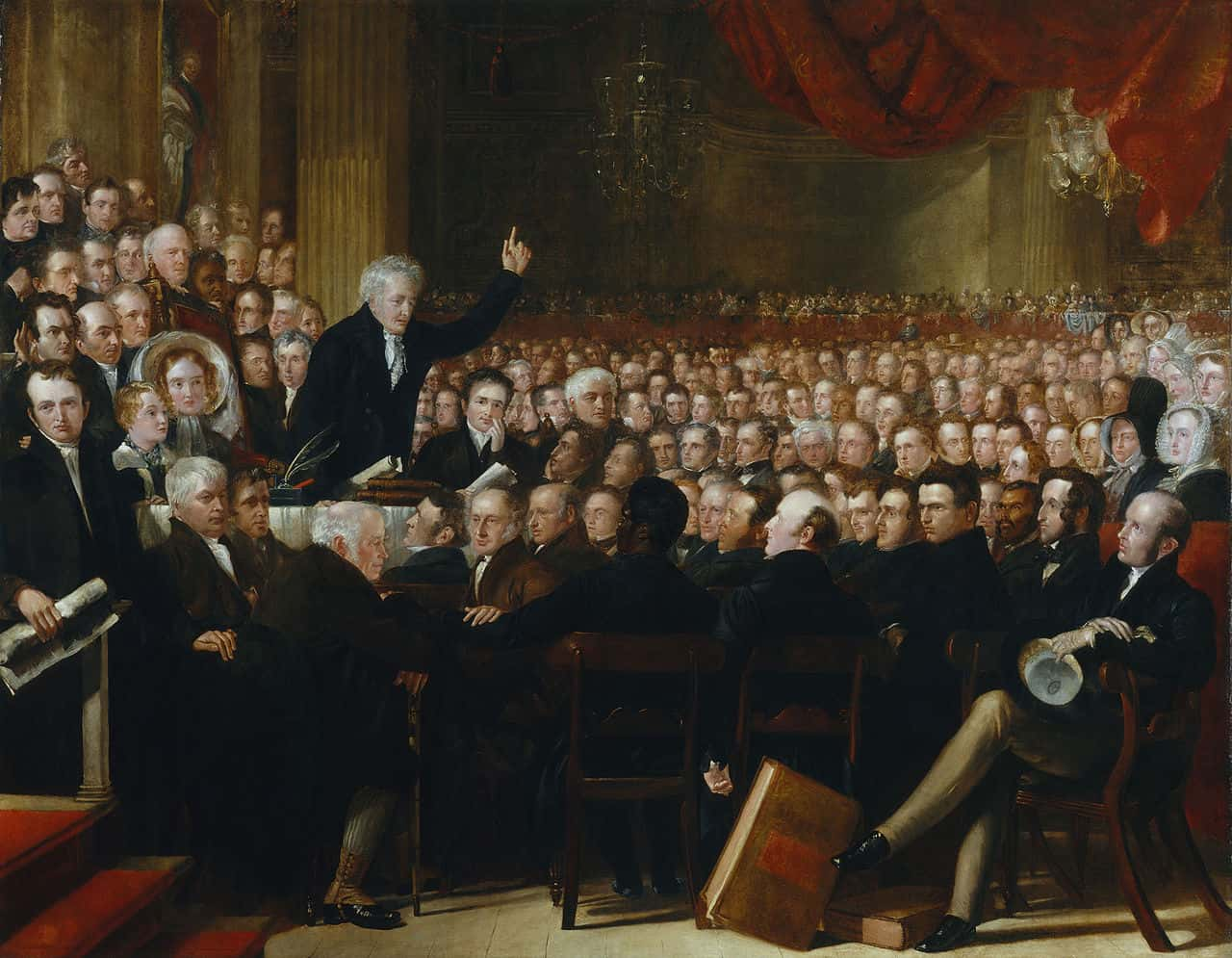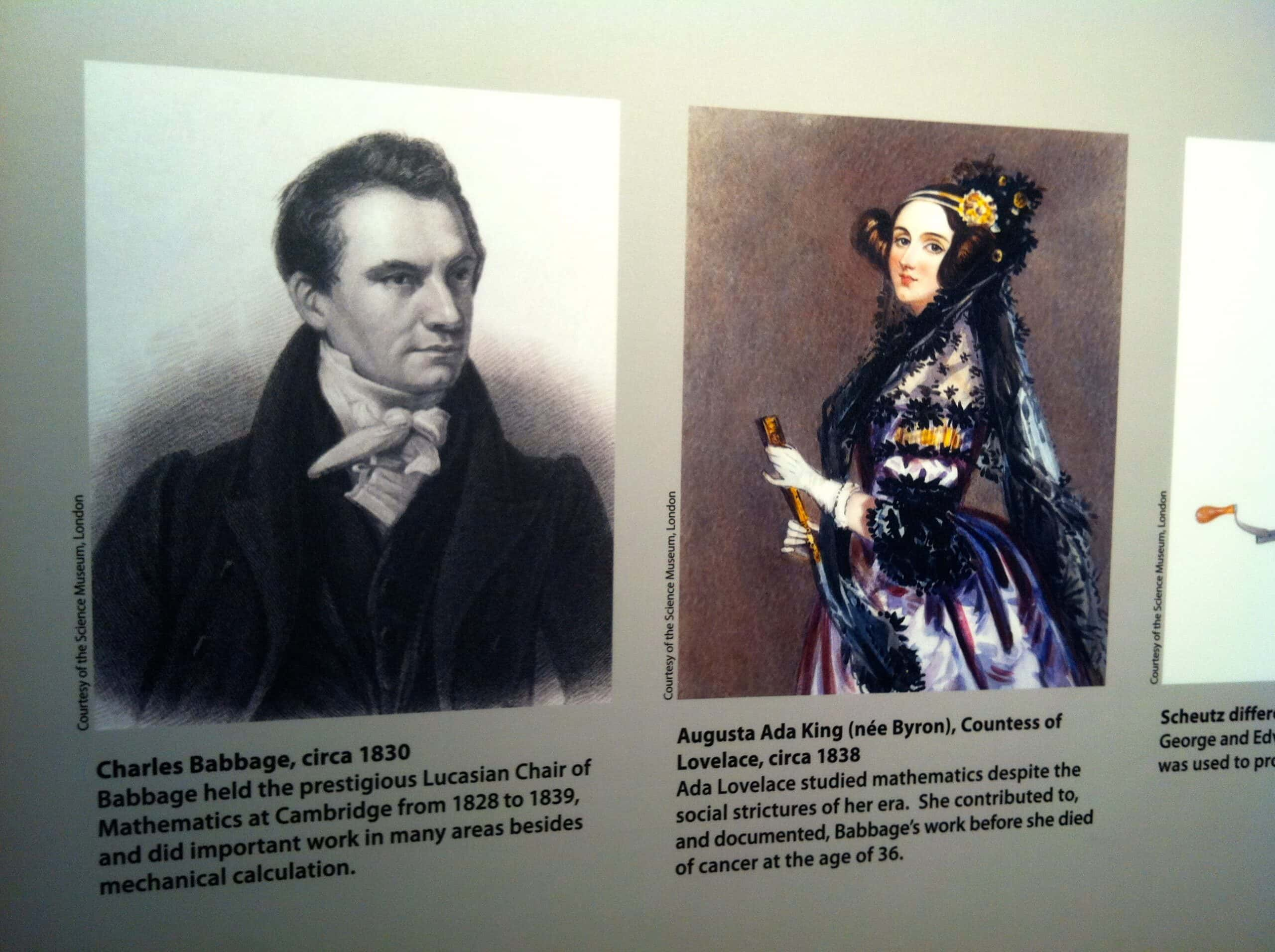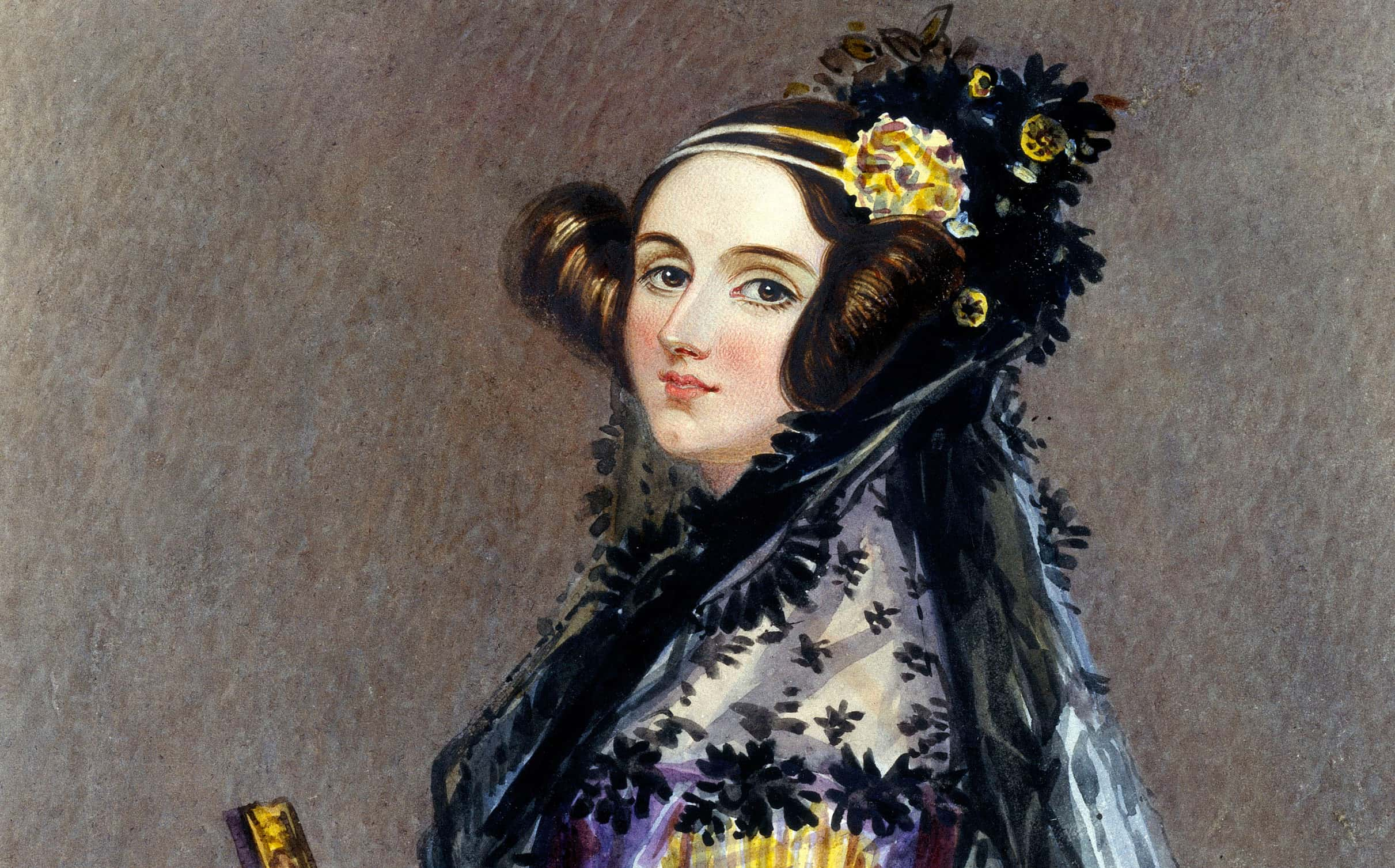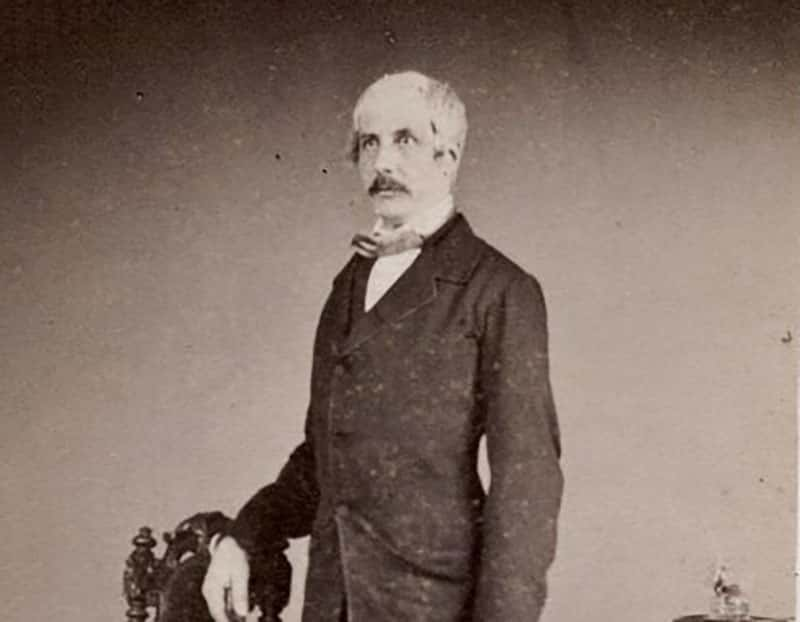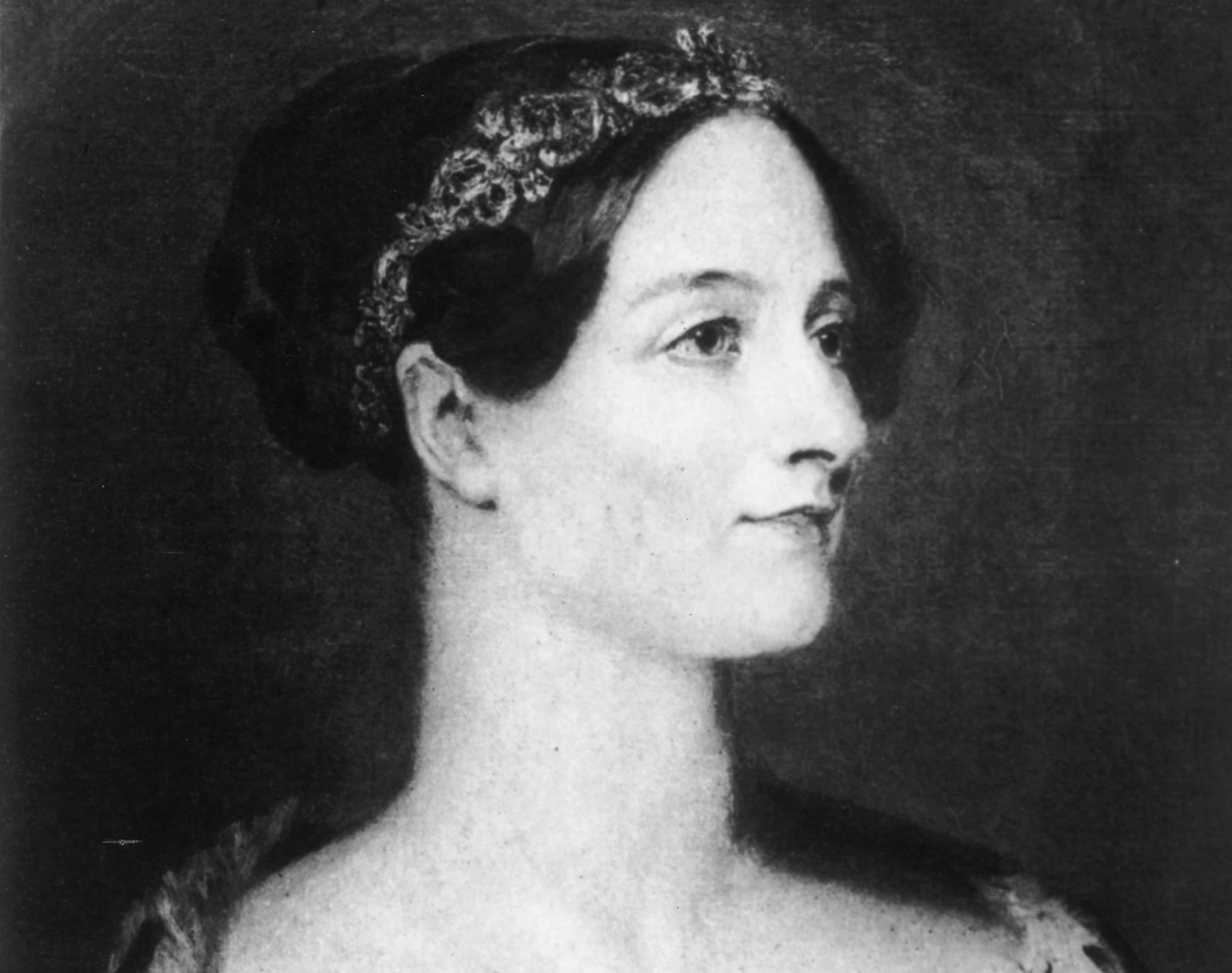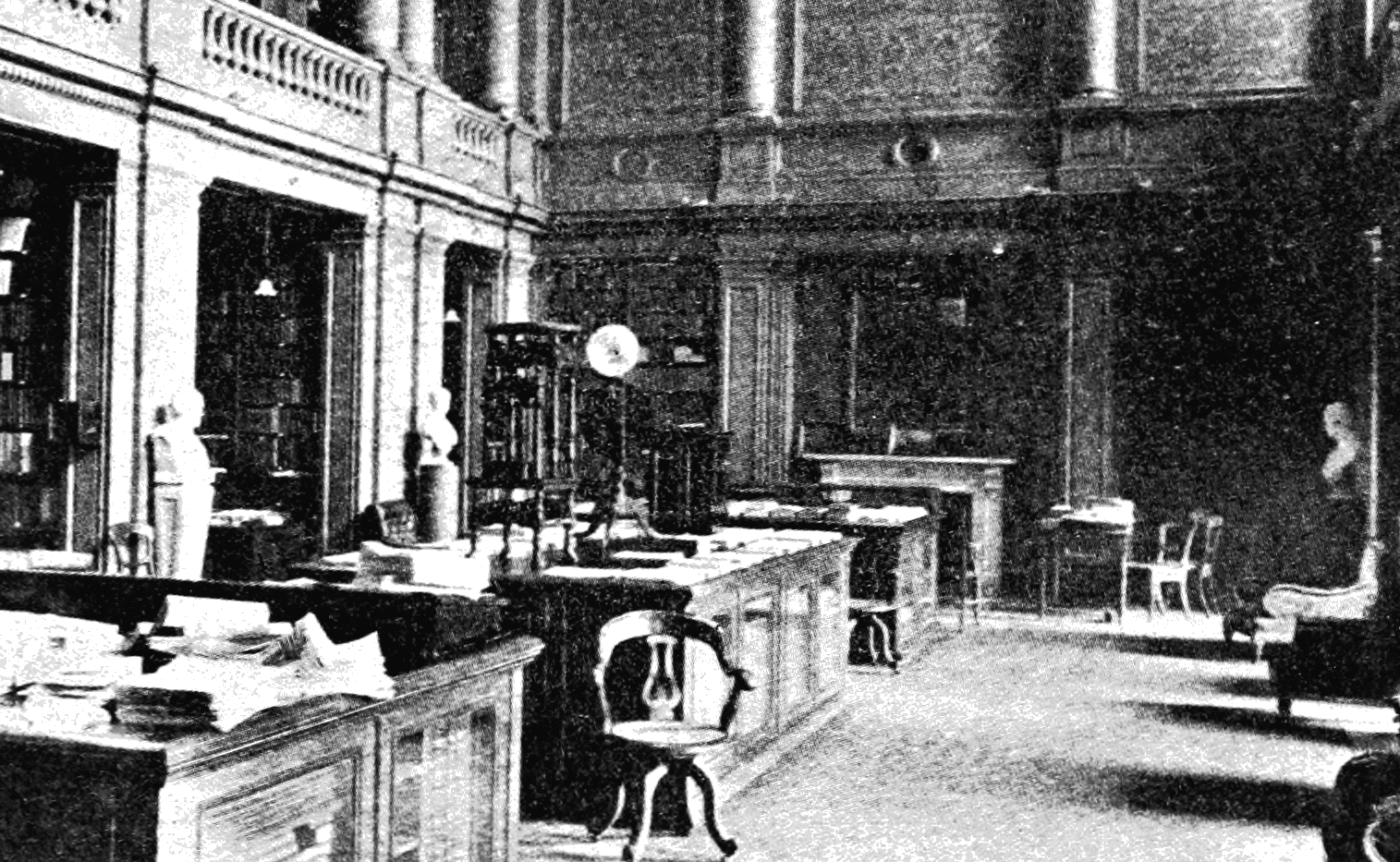Ada Lovelace's brilliance laid the groundwork for the modern world as we know it—but it wasn't a smooth road. From the moment of her birth, scandal followed her everywhere she went, right up until her tragic end.
Ada Lovelace Facts
1. Her Father Was a Rock Star
Ada Lovelace never had a chance at a boring life—not with a father like hers. Lord Byron was the Regency equivalent of a rock star, complete with the affairs, scandals, and gossip. Born on December 10, 1815, Augusta "Ada" Byron was her father's only legitimate child. Every other one of his offspring was the result of an affair—but being born in wedlock didn't save poor Ada from her tragic childhood.
2. Her Parents Were Polar Opposites
Lord Byron's marriage to Anne Isabella Milbanke, Ada's mother, was something of a shock. While Byron was an incorrigible scoundrel, Annabella, as she was called, was the exact opposite. She was stiff, moral, and adept in science. Perhaps people thought that the marriage would settle Byron down—but they couldn't have been more wrong.
3. Her Mom Was a Nerd
Ada Lovelace got her predilection for numbers from her mother. Lord Byron, ever the poet, called his new wife, "The Princess of Parallelograms." I'm sure he meant it affectionately—but almost immediately, their tenuous relationship began to tear apart at the seams.
4. Her Dad Was a Tabloid Sensation
Lord Byron was the talk of the town in English high society. People watched his every move, and his wild antics became infamous. Be it keeping a gigantic bear in his college rooms at Cambridge or leading troops in the fight for Greek Independence, there was never a dull moment for Lord Byron. It didn't take long for his conservative wife to get sick of it. Not even Ada's birth could save their marriage now.
5. She Was a Disappointment
Lord Byron's relationship with his daughter Ada got off to the worst possible start. Byron assumed that his first legitimate child would be a "glorious boy" who would continue his family name. When he discovered that he'd had a daughter, he couldn't hide his disappointment. Byron proved a pretty bad father from the instant Ada was born—and it didn't get any better from there.
6. Her Father Abandoned Her
Just a month after Ada's birth, Lord Byron and his wife separated. Not long after that, debts forced Byron to flee England for mainland Europe. He would never see his home shores, nor his daughter, again. The parting seems to have pained him at least a little; he wrote a poem for the occasion, opening with the line, "Is thy face like thy mother's my fair child! ADA! sole daughter of my house and heart?"
But no amount of poetry could make up from the fact that Byron forced Ada to grow up without a father—and sadly, her cold and distant mother provided little comfort.
7. He Cared a Little—But Not Enough
Though he never saw his little girl ever again, Ada stayed on Lord Byron's mind. He asked his family to keep him updated on her well-being, wrote of her often in his poetry, and kept a picture of her on his desk for years. But in the end, it was all empty. Based on English law at the time, Byron easily could have claimed custody of his daughter if he'd truly wanted. He never did. Instead, he left her to her heartbreaking fate.
8. Her Mother Hated Her Father...
As you can imagine, Lord Byron's exit left Ada's mother bitter and angry. She spread scandalous rumors about him whenever she could and did everything in her power to poison young Ada's mind against her father. Her treatment was extremely harsh, to be sure—but their relationship went further back than people realized.
9. Her Father Had Wild Affairs
Lord Byron had countless affairs before he married Ada's mother—in fact, his wildest tryst was with Annabella's cousin, Lady Caroline Lamb. Lamb was the one who gave Byron his most infamous label when she called him "mad, bad, and dangerous to know." She never forgave Ada's father for dumping her, and when he left her dear cousin Annabelle as well, the pair of them set about dragging his name through the mud.

History's most fascinating stories and darkest secrets, delivered to your inbox daily.
10. She Was Infamous From the Start
Annabella and Lady Lamb spread every vile rumor about Byron they could think up. They accused him of domestic violence, rampant adultery, sodomy, and even sleeping with his relatives. And all the while, young Ada was a mere infant, surrounded by gossip and controversy. Whether she liked it or not, she was infamous in English high society from the time she could walk.
11. Her Mother Tried to Erase Her Father
Annabella did everything in her power to make sure that young Ada had absolutely no relationship with her father. She had never even spoken to him when he suddenly died of a violent illness. He was 36 and Ada was just eight. In fact, Ada didn't even see a portrait of her father until she was 20 years old. Instead, her mother dominated her life, and tried to make sure that Ada never followed in her father's footsteps...
12. She Was Forced Into Math
Ada's mother taught her mathematics and logic starting when she was just a little girl. Not only was Annabella herself the Princess of Parallelograms, but she hoped that the strict schooling in numbers would help suppress her daughter's imagination. She worried that if she gave Ada even a taste of the creative arts, she would succumb to the same "madness" that plagued her father.
Unfortunately, Annabella was more concerned with making sure that Ada didn't turn out like her father than she was with, you know, being a mother—and Lovelace suffered horribly for it.
13. Her Mother Hid a Dark Secret
In public, the Lady Byron appeared every image of a loving, doting mother. But it was all a sham—behind closed doors, the dark truth came out. Annabella cared little for her child. Perhaps young Ada reminded her too much of the ex-husband she so hated, but Lady Byron spent as little time as possible with her daughter. However, she was aware that if anyone caught wind of her neglect, they might take Ada away from her. So, Annabella pretended to care deeply, even if she revealed her true nature in letters to her mother...
14. Her Mother Called Her "It"
Every time Annabella sent her mother a letter asking about Ada, she made sure to include very specific instructions on the cover: Keep all of these letters, in case she ever had to prove that she was a caring mother. Yet even still, Annabella's disdain for her daughter shone through: in one letter, she referred to Ada as "it": "I talk to it for your satisfaction, not my own, and shall be very glad when you have it under your own."
With her father gone and her mother uncaring, it should come as no surprise that young Ada Lovelace's childhood was lonely and bitter.
15. She Had a Tragic Childhood
Ada Lovelace spent her childhood alone at her mother's country house while the Lady Byron traveled England seeking out increasingly bizarre health cures. Ada had no one but her tutors, governesses, and her pet cat Mrs. Puff to keep her company. She was utterly alone—but Ada still had to be careful of what she did or said. Her mother made sure there were always people watching...
16. Her Absent Mother Spied On Her
Lady Byron's greatest obsession was making sure her daughter didn't turn out like her ex. But, since she was away so much of the time, she couldn't do all the work herself. She instructed some of her close friends to watch young Ada like a hawk, to make sure the young girl never showed any signs of "moral deviation." Ada dubbed these ladies "The Furies," and they made her life miserable.
Even worse, in her later life, Lovelace would claim that these women spread lies about her and exaggerated all of her misdeeds.
17. She Suffered From Terrible Health
As if her childhood wasn't miserable enough, Lovelace constantly suffered from painful illnesses as a little girl. For years, she experienced terrible headaches that hurt so much they made it hard to see—but that wasn't even the worst of her troubles. As a teenager, she came down with a bout of measles that was so bad, they left her paralyzed. She was confined to a bed for almost a year, and even when she recovered, she required crutches to walk for a time.
All this pain and loneliness might have broken another child—but Ada Lovelace was anything but ordinary. Even from the beginning, it was clear that this girl was something special...
18. She Wanted to Fly
Ada Lovelace spent her childhood in an ornate cage—maybe that's why, at 12 years old, she announced that she was going to learn how to fly. For most children, this would be a silly wish and nothing more. Not for Ada Lovelace. Her precocious young mind dove into the project with fervor. She tested out different materials, from feather to papers to silk. She closely studied bird anatomy for clues as to how they flew. Little Ada Lovelace put in the work...and she wasn't done yet.
19. She Was Smart Beyond Her Years
Lovelace compiled her research into a remarkably detailed book called Flyology. Inside, she not only included all of her intensive research, but she even went so far as to explain how she'd determine the optimal flight routes to navigate across England. In the end, her steam-powered flying machine never left the pages of her book, but anyone who read Flyology would quickly realize that the young girl who created it was destined for great things—and they would be right.
20. She Had Sisters...But No Family
Ada Lovelace was Lord Byron's only legitimate child, but he had many illegitimate children as well. That meant that Ada had several siblings across England. However, if she thought that these other Byrons would provide her some semblance of family, she was sorely mistaken. She never met her half-sister Allegra, who tragically died at just five years old. She did meet Elizabeth Medora Leigh, Byron's niece, but the two of them did not get along.
Elizabeth and Ada sometimes found themselves at the same court functions, but every time they did, Elizabeth avoided Ada like the plague. In the end, that would probably be for the best—but the rest of that story comes later.
21. She Fell in Love at 17
Ada Byron's mother lived in constant fear that her daughter would end up an incorrigible fiend like her father—and, to be fair, her fears weren't completely unfounded. It turned out, Ada had a bit of a wild side, and it started to come out as she grew into a young woman. She embarked on a secret affair with one of her tutors when she was 17, and the two of them hatched a plot to escape her mother's clutches forever...
22. She Tried to Escape Her Mother
Ada and her tutor/lover made a plan to elope together, but the two of them were betrayed. When Ada presented herself to her tutor's family, they instantly recognized her as the infamous daughter of Lord Byron—wherever she went, she couldn't escape her reputation. The family immediately contacted Lady Byron, who dragged her daughter back home and covered the whole thing up.
Ada must have been devastated—but little did she know, not long after her failed escape, her life was going to change forever.
23. She Had Some Strong Female Role Models
Lovelace didn't try to marry all of her tutors. Some of them simply became her close friends and confidants. Such was the case with the brilliant Mary Somerville, who educated Ada in science and mathematics. The two of them forged a strong bond and they would stay in touch for many years. But most importantly, at an extravagant party in 1833, Somerville would introduce Ada to Charles Babbage, the man with whom the rest of her life would be entwined.
24. She Knew How to Party
On June 5, 1833, fresh from her failed elopement, the 17-year-old Ada Lovelace made her debut to London high society at a lavish and flamboyant ball. Her close friend Mary Somerville was in attendance, and she showed young Ada through the crowd. One of the men they encountered was Charles Babbage. He wasn't exactly the most impressive man at the party.
In fact, he was rather downtrodden, and probably the last person you'd expect a pretty 17-year-old debutante to latch onto. But as always, Ada Lovelace thrived on upsetting expectations.
25. She Was Drawn to a Sad Old Man
There undoubtedly would have been many dashing and adventurous men at this ball—and Charles Babbage wasn't one of them. He was in his early 40s and unemployed. He made ends meet by giving public lectures, publishing fairly unremarkable scientific papers...and by dipping into the sizeable sums he'd received after his father and his wife's passing.
Not too many people considered Charles Babbage particularly interesting, but Lovelace immediately saw him for what he was: a visionary, whose ideas would eventually change the world.
26. She Lived in a Time When "Computers" Were People
There technically were computers in Lovelace and Babbage's day, but they weren't what you're picturing. Back then, a computer was a human being: Someone who did computations. A team of these "computers" would split up a complex problem and write out each aspect by hand, eventually coming to the answer through complex mathematics. It was slow, work-intensive, and inefficient.
Charles Babbage assumed there must be a better way, and he set about to prove it.
27. She Didn't Impress Babbage at First Sight
Charles Babbage didn't peg Ada Lovelace for a proto-computer scientist when he first saw her—and can you blame him? Here was this beautiful 17-year-old debutante dressed in the finest gown, attending one of her first big London parties. When Mary Somerville introduced the two, Babbage treated her like any of the other young women he met.
He tried to impress her with his Silver Lady automaton—a machine that could mimic human movements. But, to his surprise, Lovelace couldn't care less about his fancy parlor trick. Babbage then started talking about his work, and that's when Ada's eyes lit up.
28. There Was Something Special About Her
Grasping for topics, Babbage began complaining that the government wasn't giving him enough funding for his Difference Engine—an intricate machine that could perform complex calculations. This caught Ada's attention. The two of them discussed the machine the entire night. They would have made an odd pair: the young Lady and the middle-aged lecturer, excitedly talking about mathematics and mechanics.
Finally, Babbage invited Lovelace to come to his house and see his prototype Difference Engine. Thus, the defining relationship of both their lives was born.
29. She Was the Enchantress of Numbers
If Charles Babbage didn't think much of Ada Lovelace when he first laid eyes on her, that changed almost immediately. Once Lovelace saw his Difference Machine, she became obsessed, visiting him to discuss it as often as she could. Babbage quickly realized that Lovelace had an amazing gift for mathematics. He called her his "Enchantress of Numbers," and the two of them forged a lifelong partnership.
But while she spent many hours discussing analytics with Babbage, Lovelace was still a young woman in the prime of her life, and the allures of London high society kept calling.
30. She Took After Her Wild Father
Babbage wasn't the only one who Lovelace impressed at these balls. She quickly became a regular in the London party-scene, and she started to make a name for herself. She was her father's daughter: a consummate charmer who loved to dance and wasn't afraid to speak her mind. Though she'd never met Lord Byron, his friends couldn't help but notice the resemblance; not just in her face, but as one friend put it, "particularly the mouth."
It was only a matter of time before she started getting the attention of young men...
31. She Kept Her Engagement a Secret
London gossips followed Lovelace's every move. They were desperate to find out who the scandalous daughter of Lord Byron was to marry, yet Lovelace could be extremely secretive. That's how she shocked all of England when she suddenly announced her marriage to William, 8th Baron King, a wealthy English noble.
Ada became Lady King, and she and her husband lived a charmed life, splitting time between three extravagant homes. They seemed happy—but William wasn't exactly Casanova...
32. Her Husband Was...Ordinary
If nothing else, William was a man who Ada's mother would have approved of: the exact opposite of her father. By all accounts, he was a total gentleman, but quite rigid and deliberate. Like any good Victorian couple, he and Ada set about having children immediately: They wed in 1935, and Ada gave birth in 1836, 1837, and 1839—but with children came a new set of problems.
The frail health that Ada experienced when she was young returned when she had children of her own. In particular, after the birth of her second child, Annabella, Lovelace suffered from a painful illness that lasted months.
33. She Became a Countess
Ada eventually recovered from her illness, and things started to look up for this young couple. When they married, William was a mere baron, but evidently, they impressed the right people. Ada was descended from the Barons Lovelace, an ancient and extinct line of nobles, and someone decided it was time they made a comeback. William became the new Earl of Lovelace, making Ada the Countess of Lovelace—the name that would eventually go down in history.
34. Her Husband Supported Her Work
Ada Lovelace's marriage had little of the fire one would expect from Lord Byron's daughter, but their relationship was at least warm and supportive. William would even help Ada with her work: she would scribble out her formulae in pencil, and he would ink over it in pen for her. Not exactly the stuff of the gossip pages, but after her dramatic childhood, maybe that's just what Ada needed.
35. The Computer Called To Her
In the early years of her marriage, Lovelace was too busy to think much further about mathematics and Babbage's machine—but after the birth of her third child, Ada became restless. The allure of numbers called her back, and she wanted to help Babbage in his work. However, such a thing was unheard of for a fine, aristocratic lady like Ada, so she did her best to keep her interests a secret.
Lovelace wrote to Babbage asking him to help her find a mathematics teacher, but she implored him to never mention her name, so none of the gossips could find out what she was up to.
 Babbage (2008), Frame On Frame
Babbage (2008), Frame On Frame
36. She Thought Outside the Box
Lovelace eventually found a teacher and dove right in. Most of us would find long, tedious calculus problems to be a nightmare, but for Ada, this was more fun than a night out on the town. She devoured this work with delight—but couldn't help but imagine ways that these complex mathematics could be applied to the real world. In a letter to Babbage, she wondered if you could use a mathematical formula to play card games like solitaire.
This kind of thinking was unheard of in the day, but it was the exact kind of idea that would earn Lovelace her place in the history books.
37. Babbage Knew She Had Talent
Babbage often told Ada that she should publish a paper, but she always hesitated. Perhaps she feared that the scientific community would reject a woman's work. Maybe she thought the London gossips would faint at the thought of a Countess doing math. Either way, she refused Babbage every time. But Babbage knew that the world needed to see what Lovelace was capable of, so he thought up a new angle.
 Babbage (2008), Frame On Frame
Babbage (2008), Frame On Frame
38. He Basically Tricked Her Into Writing a Paper
An Italian named Luigi Menabrea wrote a paper on Babbage's conceptual "Analytical Engine"—one of the first computers in history. Babbage suggested that Lovelace translate Menebrea's paper into English. This was apparently just his sneaky way of getting Lovelace to publish her work, but I doubt even Babbage expected what Lovelace did next.
39. She Had Some Notes...
Lovelace agreed to translate Menebrea's paper, and she dove into the work. When she was finally done, she had successfully translated the paper. She also added some notes. Ok, she added a lot of notes. In the end, Lovelace's additions were three times longer than Menebrea's original work. But that wasn't even the most impressive part. There was a lot of good work in her notes, but the final addition, Note G, was different. It was special.
40. She Wrote the First Computer Program
Lovelace understood Babbage's machine better than just about anyone, and in Note G, she explained one of its practical uses. She described, in perfect detail, how to use the Analytical Engine to calculate a sequence Bernoulli numbers. Ok, that might sound like gibberish to normal people like you and me, but the important thing is this: Note G was, in effect, the first computer program ever written, making Ada Lovelace the world's first computer programmer.
41. She Had a Way With Words
Few people in the 19th century could appreciate just how important Note G was, but they still had to give Lovelace props. Babbage's Analytical Engine was something that the world had never seen before, and few people understood how it worked. Fortunately, one of the few who did was Lovelace, and she had a special gift for interpretation.
Her translation of Menebrea's article was by far the best explanation of the concept ever written at the time, and it introduced the idea of the mechanical computer to the world.
42. She and Babbage Had a Falling Out
Ada's "translation" was by far the greatest work she ever produced—but it almost destroyed her friendship with Babbage. After she's spent countless hours writing the thing, Babbage tried to add a preface complaining about how the government hadn't supported his work enough. Ada thought it was a terrible idea, but Babbage wasn't hearing any of it. Without the preface, he said, she shouldn't even bother publishing the article.
Ada was absolutely furious. She'd devoted her life to this paper, and here her closest friend was trying to kill it over a petty squabble. Eventually, she published the paper anyway, without the preface, but their friendship was strained for years after.
43. Her Husband Thought She Was Amazing
While Ada didn't receive proper support from Babbage, and many in English society thought it was scandalous for a woman to be writing scientific papers, at least she her husband backed her up. William couldn't have been more proud of his wife, and he gave copies of her paper to all his friends. He recognized the paper for what it was: a work of genius.
However, Babbage wasn't the only one who tried to take Lovelace's accomplishment away from her...
44. People Have Tried To Take Away Her Accomplishments
Many historians have tried to downplay Ada Lovelace's contributions to the field of computer science. They attribute all of the breakthroughs to Babbage and claim that Lovelace was pretty much just along for the ride. One Babbage historian went so far as to call her "manic depressive with the most amazing delusions about her own talents, and a rather shallow understanding of Charles Babbage and the Analytical Engine."
45. Her Work Speaks For Itself
Every great woman from history has her fair share of men trying to downplay her accomplishments, and Lovelace is no different. However, many historians are quick to give her the credit she deserves. Before Lovelace, no one was able to explain Babbage's work with such elegance and sophistication. Note G, in particular, had the undeniable mark of Lovelace's hand, and was a more detailed use of the Analytical Engine than even Babbage had created before.
46. She Saw the Future
Lovelace's paper featured the first-ever computer program, but it also predicted the modern computer as we know it. Before her, everyone assumed that the theoretical "computer" would simply be used to perform mathematical calculations. Lovelace predicted that a computer could be used for any number of applications, such as a machine that could create music.
Her ideas seemed ridiculous in their day, but almost two centuries later, with computers performing almost every task imaginable, she got the last laugh.
47. The Deck Was Stacked Against Her
Lovelace's paper was a work of genius, and she managed to write it despite the countless roadblocks in her way. English society believed that science was a man's work, and that made it extremely difficult for Lovelace to get what she needed. As a woman, the Royal Society denied her access to their prestigious library and the resources it contained, despite the fact that her far-less talented husband was a member.
48. Her Writing Shone
Though Lovelace devoted her life to science and math, she still had a little bit of her father's flair. Her paper should have been dry and boring, but she couldn't help but add her own poetic license. Her knack for the dramatic helped make what should have been a bunch of mathematical gobbledygook something that people could actually understand.
49. Her Mother Wasn't Impressed
Even as Ada grew up, started a family, and devoted herself to mathematics, her domineering mother remained an omnipresent thorn in her side. The Lady Byron was controlling, manipulative, and frustrating for Ada's entire life. She constantly tried to stir up drama, continually announcing that she was dying from some new ailment, then magically recovering. It was just like when Ada was a child—her mother cared only for herself.
The difference was that now, Ada had her own life, and she wasn't afraid to let her mother know it.
50. She Knew She Was Great
In Victorian society, women weren't supposed to have any aspirations beyond the home—but Ada knew she was destined for great things. In a letter to her mother, she talked about her "insatiable and restless energy" to create something of substance. She wasn't humble, either: She wrote, "I believe myself to possess a most singular combination of qualities exactly fitted to make me pre-eminently a discoverer of the hidden realities of nature."
For years, Lovelace's relationship with her mother had been cold and distant, yet here she was opening up for the first time. It seems as though once she discovered her greatest work, she cared less about what her mother thought and finally allowed herself to become her own woman.
51. Her Mother Dropped a Bombshell
Apparently, Lady Byron just couldn't deal with the fact that her daughter seemed happy—so she picked this time to drop an absolute bombshell. Remember Elizabeth Medora Leigh, Lord Byron's niece whom Ada would occasionally see at parties? Well, Lady Byron decided it was finally time she revealed her ex-husband's darkest secret...
52. Her Father Had a Child With His Sister
Lady Byron claimed that Leigh wasn't Lord Byron's niece—she was actually his daughter. This would mean that Lord Byron had had a child with his own half-sister. No wonder Leigh treated Ada so frostily at parties! But if Lady Byron hoped this shocking revelation would leave Ada stunned, she was in for a rude awakening...
Lovelace was not surprised in the least. In her response letter, she said that she'd assumed Leigh was Byron's daughter for years.
53. She Didn't Care
In a bizarre twist, Lovelace didn't blame her father at all for having an incestuous relationship with his half-sister. Instead, she blamed the sister for corrupting him! Despite the fact that she never met her dad and her mother did everything she could to make Ada hate him, it seems as though Lovelace always carried a strange affection for Lord Byron.
54. Her Mother Tried To Straighten Her Out...
So, did publishing her magnum opus change Lovelace's life forever? Not exactly. Her mother was apparently unmoved by Lovelace's personal revelation and decided that her daughter was getting a little too uppity for her own good. She hired a man named William Benjamin Carpenter to tutor Ada's kids and to be Ada's "moral instructor."
I guess Lady Byron assumed that an upstanding man like Carpenter would finally teach Ada how to act like a real lady—but she couldn't have been more wrong.
55. ...But The Plan Backfired
Carpenter was supposed to show Lovelace how to be a proper lady, but instead, she ended up corrupting him. Carpenter fell head over heels for Ada's brash personality, and he became more and more obsessed with her. He started spending a lot of time with her, always assuring her that, as a married man, his intentions were always pure. Yeah, about that...
56. She Kicked Her Suitor to the Curb
Lovelace abided by Carpenter's obsession for a while, but his advances started getting more and more obvious. Finally, she couldn't ignore it any longer—for all his cries of being a decent, married man, Carpenter was trying to start an affair. Lovelace was having none of it, and she kicked him out of the house.
57. Her Illness Came Back
Things didn't get any simpler for Lovelace after she gave Carpenter the boot. The health problems that had plagued her throughout her life returned, and she spent months on end traveling from one doctor to the next to try and get better. Unfortunately, this was Victorian England, and medicine was more of an art than a science. One of the cures her mother suggested was "mesmerism." Little wonder her health didn't improve...
58. She Tried to Numb the Pain
She tried everything, but Lovelace's health just kept getting worse and worse, leaving her in terrible pain at all times. This is when she started taking opiates to try to numb the agony.
59. She Spent a Lot of Time With Men...Too Much?
Taking opiates was totally normal in Victorian England—but don't worry, Ada found other ways to scandalize society. Remember, she was still Lord Byron's infamous daughter, and people paid attention to her every move. Gossips couldn't help but notice that Lovelace spent a whole lot of time with men who weren't her husband, and dark rumors began to swirl.
Everyone assumed Lovelace was having an affair, but that wasn't the only thing that got her in hot water...
 Babbage (2008), Frame On Frame
Babbage (2008), Frame On Frame
60. She Loved the Ponies
Science wasn't the only so-called "manly" pursuit that Lovelace enjoyed. She also indulged in gambling, and it eventually got out of control. She apparently blew over £3,000 on the ponies in the 1840s. That was bad enough—but she couldn't stop, and it was about to get so much worse.
61. She Tried to Game the System
Lovelace's love of mathematics and gambling eventually came together—with disastrous consequences. She fell in with a group of men who made increasingly large bets, and Lovelace came up with an ingenious plan. She'd create a mathematical model to game the system and dupe her friends out of their money. The only problem is, her model failed spectacularly.
Lovelace bet the farm and lost. Up to this point, she managed to keep her gambling losses a secret, but this hole was too big to cover up. She was finally forced to come clean to her husband, who was understandably furious.
62. She Was Obsessed With the Human Brain
As she grew more and more frail, Lovelace became increasingly obsessed with the mechanics of the human brain. She dreamed of creating a mathematical model for the structure of the brain, something that her knowledge of computing made her particularly equipped to do. She never achieved this goal, but it filled her thoughts throughout her final years.
Most biographers blame Lovelace's obsession with the brain on her mother, who constantly reminded her that she could fall victim to the same "madness" that corrupted her father.
63. Her Son Abandoned Her
Ada Lovelace ended up having a strained relationship with her children, just as she had had with her own mother. Her eldest son Byron left her to join the Navy, but deserted soon after. He never contacted his family ever again. Lovelace held out hope that her son had traveled to America and was living a good life there—but she never learned the heartbreaking truth.
After deserting the Navy, Byron ended up working in a dingy shipyard in England, where he died, unmarried and childless, at just 26 years old.
64. Her Kids Did Alright
Lovelace wasn't particularly close with her daughter either, though Annabella did a little better for herself than her brother. Anne, as she liked to be called, moved to the Middle East, where she became one of the world's best-known breeders of Arabian Horses. Only Lovelace's youngest child, Ralph, stayed close to home. When she and William passed away, Ralph inherited the family title. He became the 2nd Earl of Lovelace and lived out the rest of his life on their estates.
65. She Loved Her Father—But Her Son Hated Him
It seems as though Ralph Lovelace took more after his grandmother than his mother. While Ada always had a strange obsession with her mysterious father, Ralph utterly hated Lord Byron. In 1905, Ralph published a book about his family's history in which he wrote, "Lord Byron’s life contained nothing of any interest except what ought not to have been told." Ouch.
 Flickr, Fondo Antiguo de la Biblioteca de la Universidad de Sevilla
Flickr, Fondo Antiguo de la Biblioteca de la Universidad de Sevilla
66. Her Health Finally Caught Up With Her
Between gambling, opiates, and mesmerism, Lovelace's health just got worse and worse. By the 1850s, her doctors had run out of explanations: Lovelace had cancer. She was dying. The opiates that she'd been taking weren't helping anymore, so she experimented with a less-known painkiller: Cannabis. But no matter what she tried, it was too late to save her.
67. She Knew Death Was Inevitable
By 1852, there was nothing that could be done to save the 36-year-old Ada Lovelace. In one of her final correspondences, she mournfully wrote, "I begin to understand Death; which is going on quietly & gradually every minute, & will never be a thing of one particular moment." Her final days were upon her.
68. She Was Friends With Dickens
Though far too few people know her today, Ada Lovelace had made some pretty impressive friends in her life, and some of them came to visit her on her deathbed. Just a couple months before she gave out, she received a visit from none-other than Charles Dickens. She implored Dickens to read her an account of death from one of his books.
That might have terrified some people, but Lovelace had come to terms with her mortality by that point.
69. Her Mother Made Her Final Months Miserable
Though her mother had never really been there for her in life, Lady Byron completely took over Lovelace's final months. Because of this, Ada spent her last days like she had spent her childhood—almost entirely alone. Her mother never approved of any of Lovelace's friends, and she refused to allow any of them to see her daughter to say goodbye.
70. She "Repented" On Her Deathbed
As Ada Lovelace lay weak and dying, her mother still couldn't help but try to control her. She convinced Ada to repent her sinful life and devote herself to god. She also became the executor of Lovelace's will. Even at the very end, Lady Byron was sure to make everything about her.
71. She Made A Deathbed Confession
Lovelace wasn't allowed to see any of her closest friends in her final days—and soon, her husband abandoned her as well. On August 30, 1852, Lovelace called William to her bedside. She confessed something to him on that day. A deep and dark secret that she'd never revealed before.
When William heard it, he left her bedside that day and never returned. And to be fair, it was a big one.
72. The Rumors Were True
According to historians, Ada Lovelace confirmed the public's worst fears about her just before dying: She told her husband she had been unfaithful to him throughout their marriage. After stalking out of the room, the Earl of Lovelace wrote,"for the past week I have been prey to the utmost wretchedness of mind—Every cherished conviction of my married life has been unsettled".
As for who the candidate (or candidates) was?
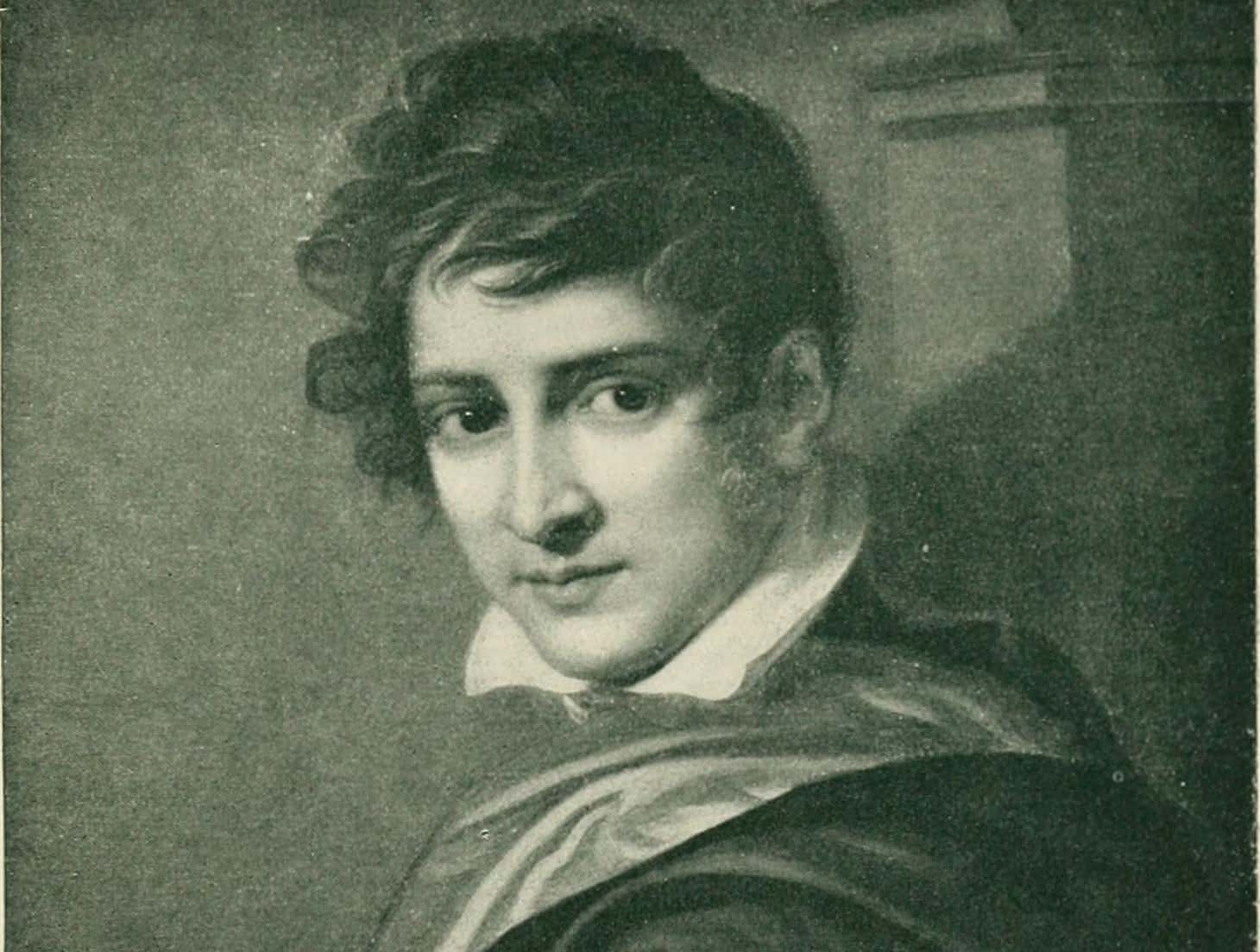 Flickr, Internet Archive Book Images
Flickr, Internet Archive Book Images
73. She Was Particularly Close to One Man
One of Ada's relationships in particular looked extremely questionable. She was close with a man named Andrew Crosse for several years, even though the pair of them were strangely secretive about their relationship. Then as Ada lay dying, one of the few people she demanded to see was Crosse.
Her mother tried to keep anyone from seeing her, but the thought of never seeing Crosse again filled Lovelace with panic. When she finally passed, she even left all of her father's possessions to Crosse.
74. She Clung To Life
Though her husband abandoned her and her mother isolated her, Ada Lovelace still hung on for three more agonizing months. She finally passed on November 27, 1852, of uterine cancer. She might have even hung on even long, but her doctors' excessive bloodletting probably hastened her end.
Her close friend and longtime correspondent Florence Nightingale later wrote, "They said she could not possibly have lived so long, were it not for the tremendous vitality of the brain, that would not die."
75. She Was Buried Next to Her Absent Father
In a surprising move, one of Ada Lovelace's last requests was to be buried next to Lord Byron, the father she'd never met. Maybe it was out of genuine affection for the man, or maybe it was just one last middle-finger to her mother. Who can say?
76. Even Her Funeral Was Lonely
Ada Lovelace was buried in an extremely small ceremony. Neither Charles Babbage, her longtime friend, nor her own mother attended the ceremony.
77. Her Family Destroyed Her Letters
Although Lovelace had confessed her sins to her husband, she still wanted to keep them hidden. One of Lovelace's last requests was for her many correspondents to collect any letters that they had from her and send them to her family.
Many obliged and sent the writings—only for Ada's son to collect them and pore over them in detail. Still, even destroyed some of those letters, and the likely scandalous details contained within.









